Вы здесь
Bath-hammam of ancient Taraz.
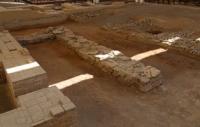
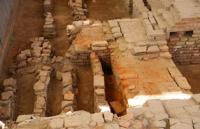

Excursion tours in Taraz.
"If you exercise, lead a healthy lifestyle and remember to go to the bathhouse, there is no need for medication"
Ibn Sina.
Ancient monuments of Taraz.
Taraz, the largest town in the Talas Valley, was an important point on the Great Silk Road. Written sources and archaeological materials give every reason to speak of the beginning of urban life in the region and the emergence of a settlement on the site of modern Taraz at the end of the first millennium BC. e. - the beginning of the first millennium A.D.
Therefore, the age of Taraz is determined by two millennia. The heyday of Taraz falls on the X - XII centuries. At this time, the city has a water supply system, the main streets are paved with stone slabs. As before, when under the Turgeshes, Taraz issued bronze coins that were widely circulated, the Taraz mint continues to mint coins in the era of Karluks and Karakhanids.
Pottery, glass making, blacksmithing, copper and jewelry crafts were highly developed. In Taraz, many were built, in particular, baths. The bathhouse in the eastern city rightfully occupied a prominent place among public buildings, because in the life of the townspeople it played one of the primary roles and after the mosque was the most visited place.
The popularity of the bath in the everyday life of the population is evidenced by its numerous characteristics, descriptions of bath episodes, lists of peculiar rules for visiting baths that have been preserved in medieval literature.
The very fact of the existence of baths in a particular city testifies to a high level of improvement. At the moment, archaeologists have managed to find two baths in Taraz. The first bath in Taraz was investigated by the Semirechensk archaeological expedition, led by A.N. Bernshtam in 1938.
The studied bath is close to a square (14 x 13.3 meters) in plan and is oriented almost exactly to the cardinal points. The firebox with a hot water source was located in the southeastern corner, and the entrance group of premises in the opposite, northwestern part of the building and consisted of a square vestibule and symmetrical corridors flanking it.
There is reason to believe that the vestibule was covered not with a dome, but with a four-meter-long vault, and that the lateral masses of walls with corridors played the role of buttresses that received the force of the vault.
Three small rooms along the south side - two square and a vestibule with a wide entrance on the west side formed an isolated "section" of the bathhouse, perhaps for guests of honor. Another group of rooms was organized along two perpendicular axes.
On the north-south axis lay a large vestibule and the following, a square (probably domed) room measuring 3.2 x 3.2 meters with niches on all sides. Behind the vestibule, there was a domed room. To the east of it was a room of the same size, and also, probably, domed, but without niches, connected with the previous room by an axial passage.
This chain of rooms in the east is closed by a small 2.1 x 2.1 meters, possibly also a domed room adjoining the firebox from the north. This, judging by its location, is a hot washing room. A large room in the northeastern corner, lying on a common (transverse) axis with the northern vestibule and side corridors, apparently served as a massage or warm washing room.
In one room a brick floor covering was preserved, in another a brick “bathtub” was found - a reservoir measuring 175 x 47 centimeters. The entrance to the bathhouse is located in the northern wall. He led into a small room with seating shelves. Its walls were decorated with fresco paintings.
This room was connected to the rooms in which the baths were located. In the walls of the rooms with baths, niches were arranged, also filled with fresco paintings. It was applied to the plaster surface with waterproof paints.
The wall painting ornament is geometric and consists of octagonal yellow stars, outlined with a black line and connected with red crosses. Other elements of the painting are octahedrons from combinations of gray quadrangles, bordered with red and yellow hexagons.
Paints and paintings were found in numerous fragments of plaster that fell from the ceiling a slightly different character. Here you can observe plant subjects in the form of elongated leaves and stems. Blue, blue and orange colors prevail.
Traces of molded decorations in the form of carved terracotta flowers, apparently tulips, with petals lowered from top to bottom, were found in the rubble of construction debris. The bath was heated by heated air circulating in channels laid under the floor and shelves.
Near one of the baths, archaeologists found a pile of coins (dirhams) made of low-grade silver, which made it possible to accurately date the construction and existence of the bath of the XIth century. The second bath, a hammam type, was investigated in 1973 under the leadership of K. Baibosynov and A. Popov.
This bath, in contrast to the "first", fully complies with the canons for the construction of this kind of structures, which have received their widest distribution in Eurasia. Unfortunately, the scientific report, as well as the material prepared for publication on the study of this structure and the adjacent territory, remained in a fragmentary state.
Attached to this article are archival photographs, a plan of the excavated hammam, as well as notes in periodicals. In 2011, in the central market, which occupies the territory of the citadel and shahristan, a small plot of land measuring 27 x 15 meters was allocated for archaeological research.
As a result of the work, two construction horizons were identified: the lower XI - X and the upper X - XII centuries. The remains of a hammam bath belong to the upper period, the preliminary publication of the study of which is the subject of this article.
For a number of reasons, archaeologists were able to uncover only the southern half of the hammam, which includes two rooms. Despite the fact that after the study of the bath in the 70s of the last century, it was completely covered with construction waste, and the surrounding area was almost completely dug up, it is perfectly preserved.
In 2012, the research of the bath continued. Also, when deepening in the southern part of the excavation, a building of the IXth - Xth centuries was revealed. and in the eastern part constructions dating back to the XIth to XIIth centuries have been excavated.
Articles on these developments in this section of the city will be published shortly. The construction in the southern part of the excavation site consists of three rooms located along one line: east - west. The premises were opened at the level of the foundation.
All rooms are characterized by combined masonry. On the gravels laid out in one row, adobe bricks were laid, then a row of pebbles followed again. The premises were not completely opened, the southern part of the building was not cleared for technical reasons.
An altar belonging to the Zoroastrian cult, remains of floor hearths and a badrab were found in the premises. In one of the rooms, a Turgesh coin was found, which, together with the finds of red clay ceramics, made it possible to date the building to the IXth - X0th centuries.
The structure in the eastern part of the excavation site has not been fully identified; it is a structure of four identified rooms. The structure in the western part was destroyed by a modern pipe trench. It is dated by finds of glazed ceramics of the XIth - XIIth centuries.
In the northern part of the excavation, the remains of the base of the southern wall of the bath were revealed and the underground heating system in the hot room was cleared, which made it possible to clarify the layout of the heat-conducting channels.
The walls of the baths (eastern, central, western and part of the southern), 1 meter thick, have survived to a height of 0.85 - 1 meter. The walls are made of red baked bricks, measuring 36 x 17 x 6 centimeters. Regular clutch - alternation of spoon and butt rows.
The southern wall of the bathhouse has been destroyed almost to the ground, with the exception of a small segment of 0.5 meters in length. According to the preserved plan drawn up by K. Baybosynov, the bathhouse was built in the form of a square, measuring 10 x 10.5 meters. There were 4 rooms in it.
There is a plumbing system (kubur), an absorbing well, channels that conduct heat. As already mentioned, in the course of research conducted in 2011 - 2012. two southern rooms were opened. One of them - room no. 1 (south-west, measuring 5 x 3 meters), was probably a pre-bath section.
Room 2 (southeast, measuring 3.5 x 3.5 meters) was a hot room, as indicated by the presence of heat conductive ducts. Also, a wall of stone slabs was cleared along the southern side of the bath at a distance of 1.3 meters from it. The wall is 9.2 meters long and 1 meter wide.
The wall in the eastern part merged with the bathhouse. The space between the walls was a corridor, probably serving as a dressing room. The entrance was located on the west side of the corridor. Subsequently, the entrance and the eastern part of the wall were pierced by a modern water pipe trench along the corridor.
Taking into account the principles of functioning of the hammam, the other two rooms remaining under the side of the excavation can be interpreted. The northeast, like room 2, was hot. The north-western one, where the visitor entered from the dressing room (room 1), most likely served as a procedural (massage) one.
The floor heating system in room No. 2 is formed by hot channels lined with a case made of baked bricks. The height of the masonry to the floor level is 0.5 meters. There are two types of bricks in the masonry. The first type is a brick measuring 22 x 22 x 4.5 centimeters, the second type is 26 x 15 x 4.5 centimeters.
The layout of the heat-conducting channels is as follows: the main channels run along the perimeter of the walls and in the center of the room. Four pockets, two through channels and two compartments with brick layouts in the center, forming circular channels, extend to the sides from the central room.
Three chimneys were found in the bathhouse in the remains of the base of the southern wall. They were used to regulate the room temperature by opening or closing vertical chimneys. The basis on which the bath heating system was erected was accumulations of gravel, sunk in a layer of yellow clay.
A layer of clay smoothed out irregularities before the construction of the channel masonry. The hot room of the bathhouse in Kayalyk was built in a similar way. The height of the masonry to the floor level is 0.5 meters. The tiles used for the masonry were 22 x 22 x 4.5 centimeters.
The floor is only partly preserved along the outer eastern wall. The floor is represented by the remains of slabs, presumably square in shape, which is typical for such buildings. The slabs are 48 centimeters wide and 5 centimeters thick.
The slabs are laid on a layer of chamotte (loess is mixed with fine pieces of ceramics and yellow raw material). The floor rested on the brickwork of heat-conducting ducts. A drainage channel was found in the western wall of the room. The floor was made with a difference in depth to the west, to drain water in the direction indicated.
The system for removing waste water from the premises of the bathhouse was based on lowering the floor level. The water splashed onto the floor in hot rooms ran down into the corners of the central wall and went through special grooves into room 1. In the outer western wall of room No. 1 there is a square hole through which the drain in the north-west direction went into the kubur.
Wastewater was discharged in kubur into an absorbing well. The well, apparently, remained under the side of the excavation. Similar sewerage structures were widespread in the 9th-13th centuries. in all cities of Central Asia and were a good indicator of urban improvement.
Part of the kubur survived at a distance of 1 meter from the western wall. However, it is possible to restore the architectural appearance of the bath-hammam, relying on the comparison of the plan and the remains of its construction with other medieval oriental baths.
It is known that the art of building baths was one of the most static trends in architecture. Building techniques, technology and architectural forms have remained unchanged in the baths for centuries. The roofs of the premises were always made in the form of domes - thanks to this, the steam, condensing, flowed down the walls, and did not fall down in drops.
Bathrooms were usually covered in two ways - with domes and vaults of the "balkhi" type. The importance and subordination of the premises was emphasized by the erection of domes over their space, which, as a rule, relied on false spherical supports "bagali" or the system of shield-shaped sails "gadjak".
The dome of the main hall rested on a system of false spherical sails "bagali", which made it possible to switch to the dome from any configuration of the hall. The sails fell on the arched openings of the entrances. In order to maximize heat preservation, low domes were erected.
More modest in form "Balkh" vaults, erected from four corners to the middle, without circles, overlapped less significant rooms, in particular technical ones. Narrow passages were most often covered with a semi-circular arch or vaults.
Since this bath did not have a central hall and consisted of four rooms, four domes of the same shape and size towered above the bath, based on considerations of visual perception. Lighting and ventilation were provided through openings in the domes. In rare cases, they were placed in the walls.
The openings in the domes were protected by slotted baked clay hoods or glass. As a rule, the baths went deep into the ground, they were placed in specially dug pits, domes protruded on the surface - this way the heat was kept in the bath.
It was not possible to determine to what depth the bath was sunk, since the nearby territory at the level of the base of the bath, is entirely represented by digging. There is no mention of the firebox in K. Baybosynov's reports, it is also absent on the plan.
There is no doubt that the firebox remained outside the edge of the excavation. Probably, it was located on the east side near hot rooms. As a rule, the firebox was located on the other side of the bath wall so that smoke and odors from it did not penetrate into the washing rooms.
The bath was heated, as a rule, with dung, brushwood, straw, and less often with firewood. This is confirmed by the large amount of small gray ash-pan with elements of coal found in the western part of the excavation.
Cleaning the heat-conducting ducts was not an easy task - floor slabs were sometimes removed to remove the soot and illuminate the aisles, this operation was carried out two to three times a year. The famous orientalist Adam Metz mentions the fact that the staff of the bath consisted of at least five people: a bathhouse attendant (hammami), an attendant (kayim), a person preparing dung (zabbal), a stoker (wakkas), and a peddler of drinking water (sakka).
A large number of spherical cones were found near the bath. These vessels were used to store medicines. The bath was an ideal place for aromatherapy, as the steamed body with open skin pores, the lungs expanded by hot steam are ready to fully accept the beneficial components of essential oils.
Medieval authors wrote about this in detail, describing the useful properties of hammam. The hammam, based on the finds of glazed ceramics, dates back to the XIth - XIIth centuries. It was at this time that burnt bricks became widespread, thanks to which Muslim architecture flourished in the East.
The mausoleums of Karakhan, Aisha-bibi and Babaji-khatun are being built in Taraz and next to it. Based on the small size of the hammam, as well as its location on the territory of the citadel, it can be classified as a palace type.
Bani-hammam is a powerful and vibrant phenomenon of Islamic culture in the life of medieval cities of the East, the significance of which goes far beyond the scope of hygiene and health procedures. Outstanding scientists and doctors Ar-Razi, Ibn-Sina, on the basis of the works of Hippocrates and Galen, developed new methods of treatment and recovery, including paying great attention to the healing possibilities of natural sources, and especially bath procedures, described in detail their use for healthy and sick people.
Their ideas about the benefits of baths and massage spread in Persia, Turkey, the Caucasus, Central Asia, the Volga region. Eastern baths had everything necessary for active healing effects of water and steam on the human body.
Baths were built over the healing springs of Erzerum, Brusa and Tbilisi. A treatise of the 11th century, belonging to the pen of Ibn Sina, contains extensive information about what medicinal decoctions and infusions should be used in a bath.
A number of recipes and prescriptions are used by modern medicine. He argued: "If you exercise, lead a healthy lifestyle and remember to go to the bathhouse, there is no need for medicine." He also pointed out the beneficial effects of the hammam on blood circulation, respiration, and the ability to get rid of excess weight.
He recommended a bath for insomnia, paralysis, nervous disorders. In his opinion, it is indispensable for catarrh of the upper respiratory tract, inflammation of the vocal cords. The bath also helps with gastrointestinal diseases: diarrhea, loss of appetite, indigestion.
Dry steam is useful for treating rheumatism. The list of diseases for which Ibn Sina recommends bath procedures is endless: jaundice and swelling of the liver, pain in the bladder, kidney stones, pain in the spleen.
The scientist also points out contraindications for visiting the hammam: epilepsy, liver blockage, headaches, noise and ringing in the ears. He warns against drinking cold water after the bath and warns about the dangers of the bath for the eyes.
The popularity of such establishments among the urban population was high. They were used to "raise a sagging mood, to relax, to meet and have a friendly conversation with friends, to meet and talk about buying and selling, about a trade deal, and showing the skill in chess and backgammon."
Jelal Essad wrote: "Baths are as necessary for a Muslim as for mosques ..." But one famous medieval calligrapher placed the maxim on the wall of the bathhouse in Mashhad: "The space of the bathhouse is like paradise, although its structure is made of clay and brick."
There were many baths in the city. In the IXth century, there were 5,000 baths in the eastern part of Baghdad alone. In the first half of the 10th century, there were already 10,000 baths there. During excavations in Afrasiab, in a small area (at the palace of the citadel), five baths were discovered, which in turn gives the possibility of presumably displaying the total number of bath complexes, of which there could have been at least sixty.
And in the 9th century in the north-west of Afrasiab, a whole block, once built up with residential buildings, was allocated for baths. Later, the number of hammams began to decline. Hammam, according to one version, owes its origin to Roman terms.
The Byzantine Empire (Second Rome), which existed until the middle of the II millennium and all this time continued to follow many Roman traditions and customs, remained true to them in relation to the baths. The Arabs of the Arabian Peninsula, closely communicating with the Byzantines, adopted some traditions from them.
Even before the advent of Islam, frequent washing was quite traditional for the peoples of the East. This is a natural necessity in hot climates. However, the Arabs only doused themselves with cold water, while acquaintance with the luxurious traditions of Roman bathing, which took place during the Arab conquest of the Levant, brought them the first of the wonders of the bath - hot steam.
The Arabs learned to take a steam bath, but did not stop pouring cold water over them. The fact is that immersion in a bath, pool or other container with water seemed unnatural to the Arabs: according to their religious beliefs, this is "bathing in their own mud."
And only with the emergence of Islam began the development of such an original phenomenon as the oriental bath. The bathhouse supplemented the ritual of ablution, which had to be performed before prayer, and at the same time one could use not only water, but also sand.
It is worth noting that all of Western Europe owes its purity to the East - the custom of performing water procedures was brought with them by the crusaders, having adopted it from the Arabs. The Arabs sought to create their own architecture, which was somewhat different from the Roman.
They preferred lower ceilings, the buildings were less pompous. In hammams, the principle of moving from one room to another with a sequential change in temperature has been preserved. Rooms differ in size, shape and height of the domed roof and distance from the heat source.
Unlike the Romans, who erected mainly huge central baths, the Arabs preferred to have several small baths in the city. There were differences in some of the procedures. If the Romans ended the bath process with classes in the library or philosophical discussions, then visitors to the hammam returned to the starting point (changing room) for rest (keif).
The attendants brought drinks here, as a rule, sherbet and coffee. Here they smoked, talked, sometimes listened to music. The Muslim ban on the image of living beings contributed to the emergence of oriental ornaments, stunning in their ghostly and mysterious beauty, which adorned the entrance and the interior of the hammams in abundance.
It is an obvious fact that both in Rome and in the East, baths were important social centers. Almost all researchers note a unifying principle in the structure and functions of Muslim baths and Roman baths. Note that in Roman baths, hot air from the firebox circulated freely between the columns on which the floor was erected, while in the hammam it was usually carried out by hot channels.
V.L. Voronina singles out as the main difference between "hammam" and antique baths the presence wet steam room, as well as the ability to regulate the heating of individual rooms of the structure. On the issue of the continuity of the traditions of building bath structures, researchers differ somewhat in their opinions.
For example, E.D. Zilivinskaya, is inclined to believe that, having adopted the ancient tradition, the peoples of the East creatively reworked it and created their own type of bath, in many respects similar to the Roman terms and at the same time in many respects different from them.
V.L. Voronina also believes, mentioning the ruins of a hydropathic building with a large swimming pool, excavated in Mohenjo-Daro, as well as the Sassanian baths, which, on the contrary, the plan and structure of Roman baths has Far Eastern roots.
O.E. Bolshakov suggests that the first baths penetrated into Central Asia from the Mediterranean regions. S. Khmelnitsky is sure that the emergence and spread of baths in the cities of Central Asia was a consequence of the inclusion of the Central Asian lands in the Caliphate and the direct cultural ties that arose in this connection with its western regions, where the traditions of Hellenism were alive.
In the Middle Ages, hammam was widespread. In Sassanian Iran, which had close contacts with Byzantium, the first baths appeared in the 6th century. The first baths in Central Asia appeared, apparently not earlier than the VIII century.
Already in the IXth century, their "triumphal march" can be traced across the expanses of the Central Asian region. Most likely, such a rapid spread of them in medieval cities is determined by two factors: the cult and everyday legalizations of Islam, as well as the widespread use of burnt bricks.
Based on the availability of the material, V.L. Voronina identifies three stages in the development of baths in Central Asia. The question of the distribution of the layout features of the medieval hammam is complicated. The numerous forms of this type of structures can be divided into two main groups: enfilade and square in plan.
The layout of the hammam is diverse and, regardless of the area of distribution, usually falls into two or three options. In a wide variety of planning options, the cruciform stands out, which makes up half of all types of planning.
It was built according to the principle of a palm, that is, in the plan, the building is a structure that consists of five rooms leading out from one central hall. The genesis of the cruciform layout can be seen in the structures of ancient times, where the caldarium of the early Roman baths had the shape of a square with niches, or in the construction of the early medieval tradition of the inhabitants of the Iranian highlands.
Materials obtained by A.N. Bernshtam during the excavation of the first bath of ancient Taraz (XI - XII centuries), indicate that in the pre-Mongol period, the ancient tradition is generally characteristic of the Central Asian region, but already in the XI - XII centuries. the first bath of the cross plan appears in Otrar.
Since the 13th century, Central Asian baths have been built only according to the oriental model. In Azerbaijan, all large public baths, known since the XIV century, are exclusively hammam, and small rural ones consist of several rectangular rooms in a row stretched along the long axis of the building.
In Georgia, as well as in the Crimea, several bath buildings of the medieval period are known, and all of them belong to the Roman-Byzantine building tradition. The widely known eastern baths of the Crimea, the researchers write, appear only in the XVIth century, during the Turkish conquests.
However, it is difficult to agree with this, since the widespread distribution of eastern baths falls on the era of the Mongol Empire in Eurasia. In Armenia, the continuity of the traditions of the construction of bath complexes in the antique style can be traced on the basis of archaeological material, starting from the II - III centuries. n. e. (bathhouse of the Garni fortress) up to the XVIIIth - XIXth centuries.
An exception is the Onentsa bathhouse in Ani, which is an example of a classic hammam. In Ancient Kiev, a bathhouse was opened, built on the Byzantine model. On the territory of the Golden Horde, a state whose social and urban life was formed under the influence of the conquered peoples of not only the East, but also the West, both of the above building traditions are present.
Thus, hammams were most widespread in countries gravitating towards the East, while the ancient building tradition continued to predominate in the construction of bath houses in the western regions in the Middle Ages.
On the territory of Kazakhstan, medieval baths, in addition to Taraz and Otrar, were found in Kayalyk, Zhaiyks, Shoytobe (Shavgar), Aktobe, Ekpendy, Saraichik. Both baths in Taraz have a unique layout that has no analogues in Kazakhstan and Central Asia.
Local architects have created their own way of planning the construction of structures of this type. This shows their high level of knowledge in architecture. Hammam has survived almost unchanged in Central Asia to this day.
Even in the last century, Kali Yunus baths in Taraz and a bathhouse on the territory of the Khoja Ahmed Yassaui cult complex in Turkestan functioned in Kazakhstan. Since the beginning of the 20th century, hammams have fallen into decline.
However, the hammam turned out to be too bright and distinctive phenomenon of Eastern culture to disappear without a trace. Gradually, voices in favor of preserving the heritage of national culture became more and more audible.
Hammams have begun to revive. The development of tourism in Islamic countries played a significant role in this. In Kazakhstan and the countries of Central Asia - the former Soviet republics - today the old historical buildings of the hammams are being intensively restored and new ones are being built, while striving not only to preserve the national flavor, but also follow the canons of classical architecture.
In our country, the restored baths in Otrar, Turkestan, the Kali Yunus bath in Taraz and the "Arasan" bath complexes built in the southern capital, which also have a hammam bath, are vivid examples in our country.
In the future, it is planned to create an archaeological park in Taraz on the site of the investigated settlement. Hammam will take a worthy place in it, as part of the rich cultural heritage of Kazakhstan.
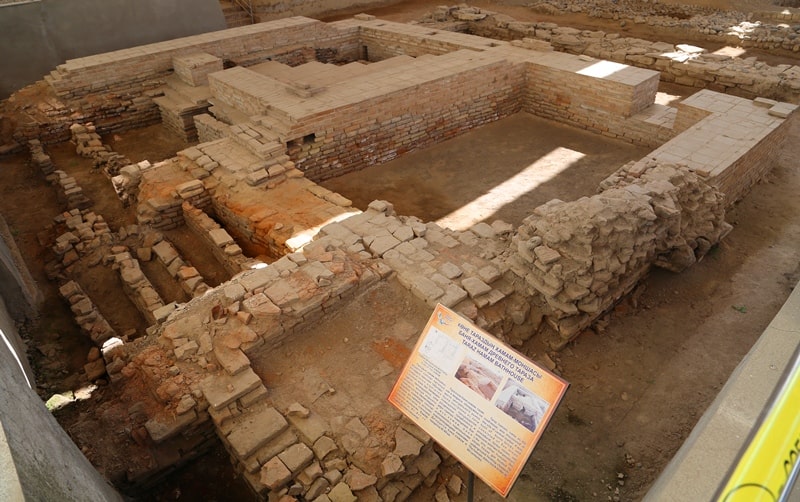
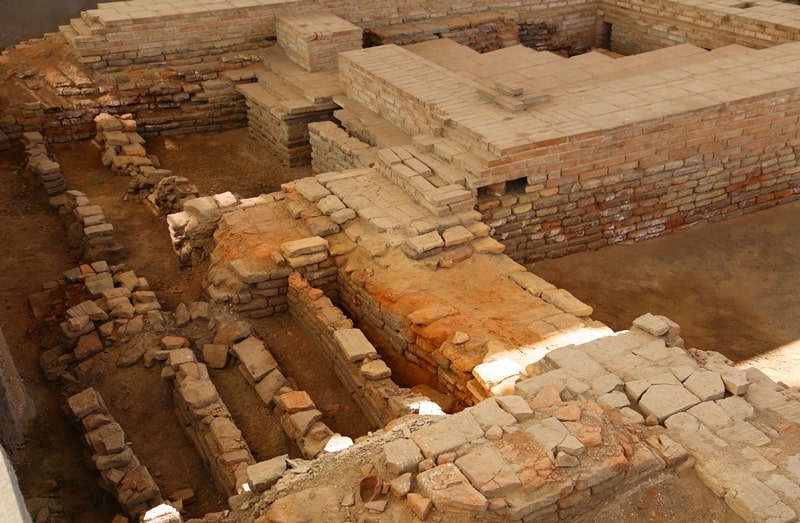
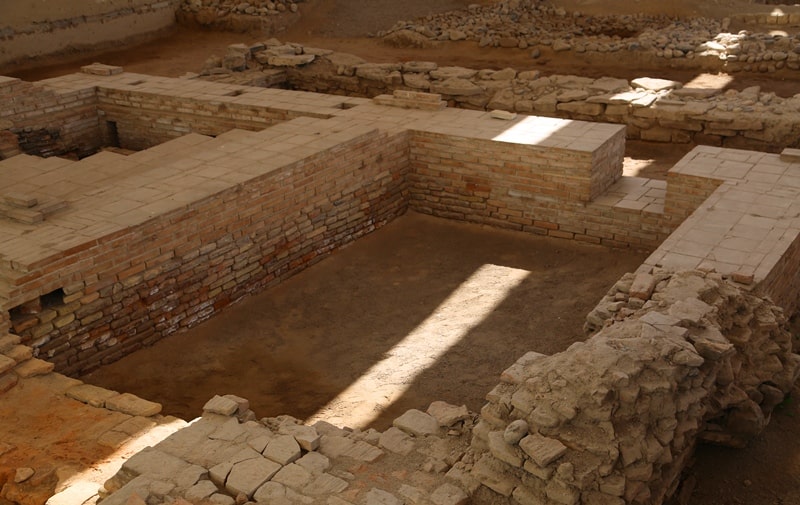
Authority:
K.M. Baipakov, D.A. Voyakin, M.K.Seytkaliev. R.N. Buranbaev. "Some results of the study of the bath-hammam at the Taraz settlement in 2012".
Photos by
Alexander Petrov.







